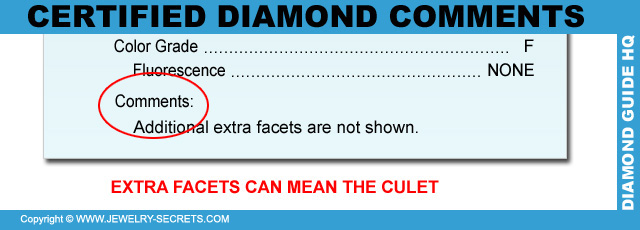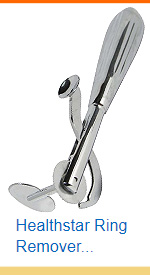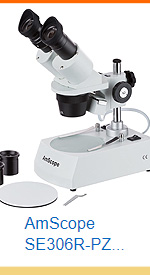DIAMOND CULET
LEARN ALL ABOUT THE CULET OF A DIAMOND
This post contains affiliate links. If you use these links to buy something I may earn a commission. Thanks! As an Amazon Associate I also earn from qualifying purchases.

What is a diamond culet?
A culet is a facet at the very bottom of the diamond.
Does the culet matter?
You bet it does. :)
A fully round brilliant cut diamond normally has 58 facets that make up the surface of the stone. One of these facets is called the culet and it sits at the base of the diamond where the facets come to a sharp point or tip. The culet facet is octagon in shape (8 sides) and lays parallel the table facet of the diamond.
Chances are good you’ll never notice the culet facet, unless that facet appears too large, or the culet gets chipped.
Not all diamonds have a culet though. Sometimes a diamond will come to a very sharp point and the diamond will only have 57 facets. This is considered as “No Culet” or “None” and doesn’t affect the look, feel or value of the diamond in the least.
See an image of a diamond culet below…

So why have a culet?
There is only one sole purpose in life for a culet… to prevent that sharp tip from breaking or chipping off. And that’s it!!!
It’s pretty much the exact same reason why diamonds have girdles, it flattens out the point (weakest part of the diamond) and keeps it from shattering if it gets bumped or hit.
Breaking the culet
Without that bottom facet, it wouldn’t take much effort to break the tip off. This can happen easily if the jeweler is setting the diamond into a head (prongs on a ring) and not paying much attention. He can shove the diamond too far down and crush the tip against the metal cup. I’ve seen it happen before and it isn’t pretty. It can instantly damage a high clarity and high color diamond, decrease the value and make the culet stand out like a sore thumb. :(
What’s scary about all this is the fact that the jeweler may not even know he chipped the stone. And you may not either, if you just pick up your ring from the jewelry store without microscoping the stone to make sure there are no new chips or breaks on the culet, facets or girdle.
A chipped girdle can look like the culet in the diagram below…

GIA culet sizes
GIA grades and rates culets with 8 different classifications (viewed face up with 10x magnification). Take a look…

- NONE (no culet): No culet or polished facet whatsoever at 10x magnification (what diamonds are graded with). These culets can be chipped easily if not careful.
- Very Small Culet: A very small culet is very difficult to see under 10x magnification. They can still chip or break if the jeweler is not careful enough.
- Small Culet: A small culet is difficult to see under a microscope or jeweler’s loupe. These are some of the best culet sizes to have in my opinion.
- Medium Culet: A medium culet is distinctly visible under 10x magnification. This is the culet size that most average people will begin to see under the scope. Smaller culets just appear like a pinpoint or dot.
- Slightly Large Culets: Slightly large culets are obvious under 10x magnification. They get bigger and are easier to spot. You could possibly see a slightly large culet with the naked eye as well.
- Large Culet: A large culet is large and very obvious under magnification. Plus, this Size of culet could look like a hole in the stone even without magnification.
- Very Large Culet: Very large culets get very distracting. When you look at a diamond with a very large culet, your eyes will be drawn to that hole in the center of the stone. These are easy to see under magnification and may stand out like an eye sore.
- Extremely Large Culet: These sizes of culets look so big and so obvious that it looks like a large hole in the stone. You can almost see right through it. Old mine cut diamonds and old European cut diamonds often had these huge culets because the diamond cutter would simply lop the end of the diamond off to prevent it from chipping or breaking. See the image below…

GIA culet grades
Now that you’ve seen the 8 different culet sizes, let’s see how they are Graded by GIA using their new cut grade system…
- None: Excellent
- Very Small: Excellent
- Small: Excellent
- Medium: Very Good
- Slightly Large: Good
- Large: Good
- Very Large: Fair
- Extremely Large: Poor
These size of the culet will be listed on the GIA diamond report under proportions as shown in the image below…

Do note that just because a culet gets an excellent rating (None, Very Small or Small), this doesn’t mean that the rest of the diamond is graded excellent. A poorly cut diamond can still have an excellent or very good culet grade.
Best size of culet to have
The best culet sizes to have are: None, Very Small, Small and Medium sized culets.
These are the best and smallest sizes of culets, but no matter what size of culet you get, the jeweler still has to be careful when setting the stone in a mounting (especially no culet or very small culets). The last thing that anyone wants to hear is that accidental “SNAP” of an $8,000 diamond breaking!!! That would not be cool.
Once the diamond is set in a ring, the culet is protected and you won’t have to worry about it anymore… not unlike the still exposed edge of the diamond girdle, which is something you always need to be concerned about.
I usually advise buying a small or medium culet, just in case. :) You never know.
Because a chipped culet (or large culets), can change the depth of the diamond and the way light reacts with the stone. Plus, it can depreciate the value of the stone and that is a chance I’d rather not take.
Keep in mind, an experienced jeweler today can set a diamond with no culet perfectly and without chipping it… BUT, if you ever need to get your ring repaired, re-tipped or reset in the future, that culet may not be so lucky. You take your chances of having it chip or break.
Abrasions on the culet
An abrasion is where the perfect, clean, sharp edges of the culet facets are worn away or rounded off… Sort of like sanding the bottom with sandpaper. It may even feel rough or bumpy.
These abrasions can be caused by loose diamonds rubbing against each other in a diamond parcel or through poor cutting during the cutting process.
In the face up position, an abrasion may look blurry, fuzzy, white or jagged like in the image below…

Extra culet facet
Not all culet facets are parallel to the table of the diamond. Not all culets are octagon in shape either. Some bottom facets are on an angle (sloped) and larger. This is possibly due to removing an inclusion that fell on the very tip of the stone.
This type of Facet is not called a culet anymore, it’s actually called an extra facet.
On a GIA diamond report, the culet will then be listed as “none“, but under the comments section of the report you’ll see something like this: additional extra facets are not shown. As in the image below…

Culet facet symmetry
The culet is at the point where the 8 pavilion main facets meet and you can get a good idea about the make of a diamond by viewing this facet in the center of the stone.
What you want to look for, is where the culet is located.
Is the culet directly in the center of the stone, or is it off to one side (off-center)?
If the culet is off-center, it can greatly alter the brilliance and sparkle of the stone. Dead center is where you want it to be like in the images below…

Little things like this aren’t so obvious at first… until you know what to look for.
It really does make a big difference to the light performance of the diamond and the overall cut grade of the stone. Everything goes hand in hand.
One small culet, one huge impact.
Isn’t it time you checked out your culet today?
Cheers! :)


















Thank you for this article. I had some rings made smaller and I needed to know what I was talking about when I saw the point at the bottom was at an angle and a missing stone badly repaired on another ring. I didn’t check, went by their great reputation. Nice guys, but not fine jewelers.